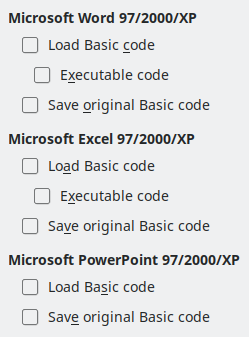VBA Properties
Specifies the general properties for loading and saving Microsoft Office documents with VBA (Visual Basic for Applications) code.
To access this command...
Choose Tools - Options - Load/Save - VBA Properties.

Microsoft Word 97/2000/XP
Select the settings for Microsoft Word documents.
Load Basic code
Loads and saves the Basic code from a Microsoft document as a special Office Basic module with the document. The disabled Microsoft Basic code is visible in the Office Basic IDE between Sub and End Sub. You can edit the code. When saving the document in Office format, the Basic code is saved as well. When saving in another format, the Basic code from the Office Basic IDE is not saved.
Executable code
The VBA (Visual Basic for Applications) code will be loaded ready to be executed. If this check box is not marked, the VBA code will be commented out so it can be inspected, but will not run.
After loading the VBA code, Office inserts the statement Option VBASupport 1 in every Basic module to enable a limited support for VBA statements, functions and objects. See Option VBASupport Statement for more information.
Save original Basic code
Specifies that the original Microsoft Basic code contained in the document is held in a special internal memory for as long as the document remains loaded in Office. When saving the document in Microsoft format the Microsoft Basic is saved again with the code in an unchanged form.
When saving in a format other than Microsoft Format, the Microsoft Basic Code is not saved. For example, if the document contains Microsoft Basic Code and you save it in Office format, you will be warned that the Microsoft Basic Code will not be saved.
The Save original Basic code check box takes precedence over the Load Basic code check box. If both boxes are marked and you edit the disabled Basic Code in the Office Basic IDE, the original Microsoft Basic code will be saved when saving in the Microsoft format. A message appears to inform you of this.
To remove any possible Microsoft Basic macro viruses from the Microsoft document, unmark the Save Original Basic Code check box and save the document in Microsoft format. The document will be saved without the Microsoft Basic code.
Microsoft Excel 97/2000/XP
Specifies the settings for documents in Microsoft Excel.
Load Basic code
Loads and saves the Basic code from a Microsoft document as a special Office Basic module with the document. The disabled Microsoft Basic code is visible in the Office Basic IDE between Sub and End Sub. You can edit the code. When saving the document in Office format, the Basic code is saved as well. When saving in another format, the Basic code from the Office Basic IDE is not saved.
Executable code
The VBA (Visual Basic for Applications) code will be loaded ready to be executed. If this check box is not marked, the VBA code will be commented out so it can be inspected, but will not run.
After loading the VBA code, Office inserts the statement Option VBASupport 1 in every Basic module to enable a limited support for VBA statements, functions and objects. See Option VBASupport Statement for more information.
Save original Basic code
Specifies that the original Microsoft Basic code contained in the document is held in a special internal memory for as long as the document remains loaded in Office. When saving the document in Microsoft format the Microsoft Basic is saved again with the code in an unchanged form.
When saving in a format other than Microsoft Format, the Microsoft Basic Code is not saved. For example, if the document contains Microsoft Basic Code and you save it in Office format, you will be warned that the Microsoft Basic Code will not be saved.
The Save original Basic code check box takes precedence over the Load Basic code check box. If both boxes are marked and you edit the disabled Basic Code in the Office Basic IDE, the original Microsoft Basic code will be saved when saving in the Microsoft format. A message appears to inform you of this.
To remove any possible Microsoft Basic macro viruses from the Microsoft document, unmark the Save Original Basic Code check box and save the document in Microsoft format. The document will be saved without the Microsoft Basic code.
Microsoft PowerPoint 97/2000/XP
Specifies the settings for documents in Microsoft PowerPoint.
Load Basic code
Loads and saves the Basic code from a Microsoft document as a special Office Basic module with the document. The disabled Microsoft Basic code is visible in the Office Basic IDE between Sub and End Sub. You can edit the code. When saving the document in Office format, the Basic code is saved as well. When saving in another format, the Basic code from the Office Basic IDE is not saved.
Save original Basic code
Specifies that the original Microsoft Basic code contained in the document is held in a special internal memory for as long as the document remains loaded in Office. When saving the document in Microsoft format the Microsoft Basic is saved again with the code in an unchanged form.
When saving in a format other than Microsoft Format, the Microsoft Basic Code is not saved. For example, if the document contains Microsoft Basic Code and you save it in Office format, you will be warned that the Microsoft Basic Code will not be saved.
The Save original Basic code check box takes precedence over the Load Basic code check box. If both boxes are marked and you edit the disabled Basic Code in the Office Basic IDE, the original Microsoft Basic code will be saved when saving in the Microsoft format. A message appears to inform you of this.
To remove any possible Microsoft Basic macro viruses from the Microsoft document, unmark the Save Original Basic Code check box and save the document in Microsoft format. The document will be saved without the Microsoft Basic code.